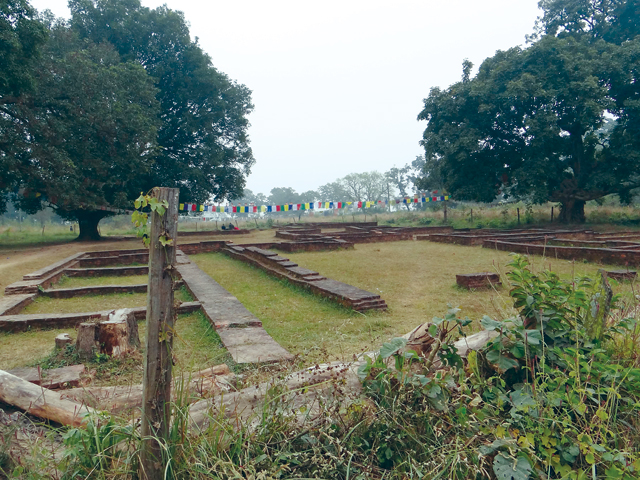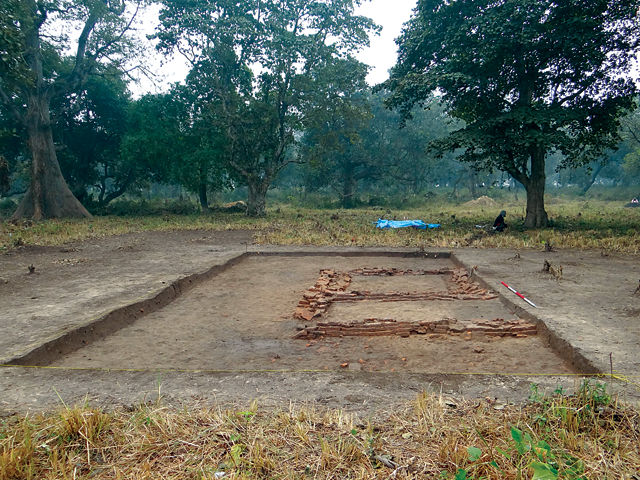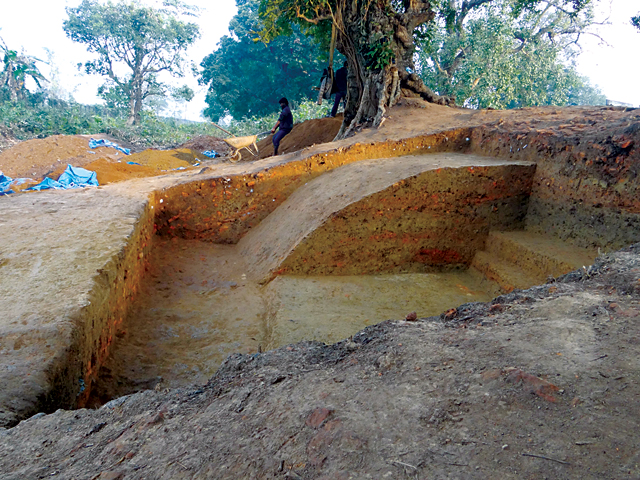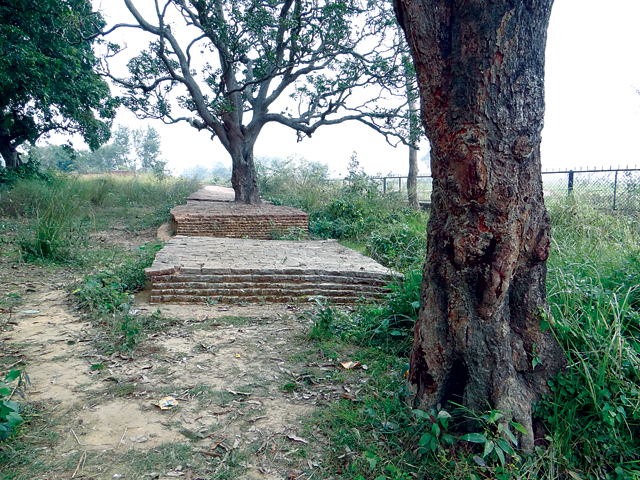The quest to identify the ancient city of Kapilavastu, the place where the Buddha spent the early years of his life as Prince Siddhartha Gautama, has been going on for more than a century.

The name Kapilavastu refers to the kingdom as well as the administrative centerof the Shakya dynasty, ruled by Prince Siddhartha’s father King Suddhodhana in the6th century B.C. It was where the Buddha grew up before giving up all worldly pleasures, as well as his family, in search of the truth. He departed in the middle of a full moon night through the eastern gateway, also known as the “Mahabhinishkramana Dwara”.This archaeological as well as historical site of Tilaurakot, or ancient Kapilvastu, is situated 3 km north of Taulihawa, the district head quarters of Kapilvastu, Lumbini in the central part of the Tarai region of Nepal.
 Archaeological excavation, in my experience is a very exciting and elaborate task which needs to be performed with great responsibility. My excitement of what it would all be about started right from the time when I started laying out a trench, digging it and the excitement built up when bricks structures emerged some two feet below the top soil. It is all a very slow process, the digging is to be done very carefully, so no remains below the soil gets damaged. Shovels, hand-pic, trowels etc are used, and every time a brick structure is exposed, the sand, mud, and roots have to be brushed away to expose as much of the structure as possible, to photograph and analyze. As I dug on, and more structures were seen, my curiosity peaked as to what these structures are and how much bigger they could be. The excitement of finding some valuable treasures is always there, and many visitors often ask “did you find any gold and precious stones?” little do they understand that even a piece of pottery to an archaeologist is equivalent to gold and precious stones! However findings of various terracotta human and animal figurines, broken parts of terracotta figures, and kilos and kilos of fragmented pottery were excavated which are sent for cleaning and sorting and analyzing to place their chronology.
Archaeological excavation, in my experience is a very exciting and elaborate task which needs to be performed with great responsibility. My excitement of what it would all be about started right from the time when I started laying out a trench, digging it and the excitement built up when bricks structures emerged some two feet below the top soil. It is all a very slow process, the digging is to be done very carefully, so no remains below the soil gets damaged. Shovels, hand-pic, trowels etc are used, and every time a brick structure is exposed, the sand, mud, and roots have to be brushed away to expose as much of the structure as possible, to photograph and analyze. As I dug on, and more structures were seen, my curiosity peaked as to what these structures are and how much bigger they could be. The excitement of finding some valuable treasures is always there, and many visitors often ask “did you find any gold and precious stones?” little do they understand that even a piece of pottery to an archaeologist is equivalent to gold and precious stones! However findings of various terracotta human and animal figurines, broken parts of terracotta figures, and kilos and kilos of fragmented pottery were excavated which are sent for cleaning and sorting and analyzing to place their chronology.

Besides the findings of numerous architectural structures of the Sunga –Kushan era (2nd century B.C. - 2nd century A.D.), the highlight of the excavations this year were the findings of the postholes along the rampart of the fortification wall. A series of postholes make a palisade. More than 300 different media outlets, a majority focusing on the postholes, covered this year’s excavation. But what is a posthole and why is its discovery so important? Postholes are cavities in the earth’s surface where timber posts for fences are erected. The finding of these postholes takes us back to anera before bricks and concrete, to the age of wood and mud, possibly in the 3rd century B.C. Ofcourse, the timber has long decayed, leaving only a series of holes. The soil from this strata and postholes has been taken for OSL dating by renowned geo-archaeologist Dr Ian Simpson of the University of Stirling, Ireland. The results are slated to be out by August this year, after they are tallied with other forms of dating.This year’s excavation was headed by Kosh Prasad Acharya, former Director General of the Department of Archaeology, Nepal, and Professor Robin Conningham, Pro Vice-Chancellor of Durham University in the UK.

Various explorations and archaeological excavations have been conducted in the past, beginning in the late 19th century when Indian archaeologist Dr. P.C. Mukherjee identified present day Tilaurakot as the ancient city of Kapilavastu. History is based on archaeological exploration and excavation. Explorations are of two types - traditional and scientific. Traditional explorationis conducted on the basis of folklore and literary sources such asmythology, legends, ancient religious texts and scriptures. Scientific exploration, on the other hand, uses various kinds of tools (geophysics, magnatometre, Ground Penetrating Radar (GPR), etc.)and methodologies to survey the surface of the earth for objects below the soil.
Historical sites all over the world have been identified after using literary sources of the area as guides. Just like the ancient city of Troy was re-discovered after German archaeologist Hienrich Schlieman took clues from the ancient Greek mythology Iliad, so was it with ancient Kapilavastu. Although it was first uncovered in 1893 by Major Jaskaran Singh, official investigations started only in 1895, when Dr. A Furher, archaeological surveyor of the East India Company, was assigned to investigate the area. Furher borrowed clues from ancient Ceylonese Buddhist Scriptures such as the Deegha Nikaya and the Ambatta Sutta,as well as from the Divyavadana, which located Kapilvastu on the banks of the river Bhagiratha. Kapilavastu was described as lying on the lap of the Himalayas to the north, with the Rohini River on the east, the Lumbini gardens and the Acchiravati River (present day Rapti) to its west and, to the south, the Kosala and Malla Kingdoms. Furher also looked into the travel accounts of Chinese travelers from the 5th and 7thcentury A.D. respectively. The reports of Chinese traveler Fa-Hsien mentioned Kapilavastu as a vast expanse of ruins when he visited in the 5thcentury A.D. Huien-Tsang, who came to the area in the 7thcentury A.D., also gave similar details.
The capitals of the then contemporary kingdoms, or the 16 Mahajanapadas of north India, such as Anga, Magadha, Koshala, Kashi, etc. each had a fortification wall, a single or double moat, four gateways in as many cardinal directions, and linkages to trade routes. Scholars have pointed out that Tilaurakot has similar features, thus making it easier to hypothetically link it to ancient Kapilavastu. Because history without archeology is incomplete, and archaeology helps in reconstructing history, various archaeological excavations are being carried out at Tilaurakot to prove the above theories true.
After Dr. Furher, Indian archaeologist Dr. P.C. Mukherjee carried out excavations in 1899 to “explore and fix the position of Kapilvastu as accurately as possible.” Dr. Mukherjee can be credited for discovering a fortification wall around a mound, the eastern gateway, a pond to the northeast and other ruins within the fort.
In 1962, Tilourakot was explored by Devala Mitra, who laid out a trench in the nothern western part of the mound across the fortification wall. Some of the findings from her excavationwere pottery, silver and copper coins, terracotta figurinesof humans and animals, stone objects, glass beads, terracotta bangles, gold and silver ornaments and embellishments, bone and ivory objects, and roof tiles. On the basis of these discoveries, she declaredthe site to have not existed earlier than the 3rd-2ndcentury BC. This led to lot of controversies in the archaeological community worldwide, and the Department of Archaeology (DOA), Nepal disagreed with Mitra’s conclusions.
From 1967 onwards, various excavation activities were carried out at Tilaurakot by the Government of Nepal and the Department of Archaeology. In a bid to restudy the site, the DOA started archaeological activities headed by their own archaeologist Tara Nanda Mishra in 1967. In 1974, analysis from the excavations by B.K. Rijal divided the chronology of Tilaurakot into five periods - Period I (11th-8th century B.C.), Period II (6th-5th century B.C.), Period III (3rd-2nd century B.C. a.k.a. the Mauryan era), Period IV (2ndcentury B.C.-1stcentury A.D. a.k.a. the Sunga period), and Period V (1st-2ndcentury A.D. a.k.a. the Kushan era).Between 1976-78, Risho University, Japan also conducted excavations and research activities. Since 2013, the Department of Archaeology, Lumbini Development Trust, UNESCO Nepal and University of Durham, UK have conducted archaeological excavations with participation from Tribhuvan University. In the excavation conducted this year, 13 students from the Central Department of Nepalese History, Culture and Archaeology TU also took part.
It is important to note that these archaeological investigations broaden our understanding of historical sites. It was only in 1996, after years of excavations, that Lumbini was declared a World Heritage Site and the birthplace of the Buddha. The plan to include Kapilavastu, or present day Tilaurakot, as a World Heritage Site still continues. Although traditional and literary sources leave no doubt as to Tilaurakot’s identity as ancient Kapilavastu, the very latest equipments of investigation and explorationhave taken broader steps in identifying it as as the capital of the Shakya kingdom, where the Buddha spent 29 years of his life as Prince Siddhartha Gautama.










